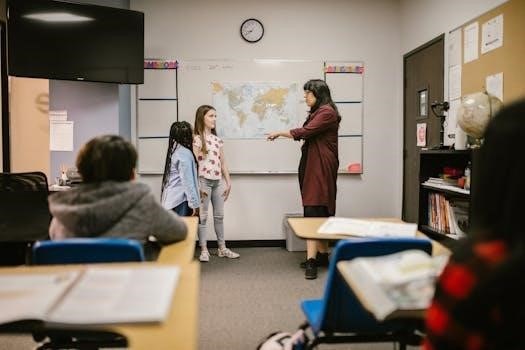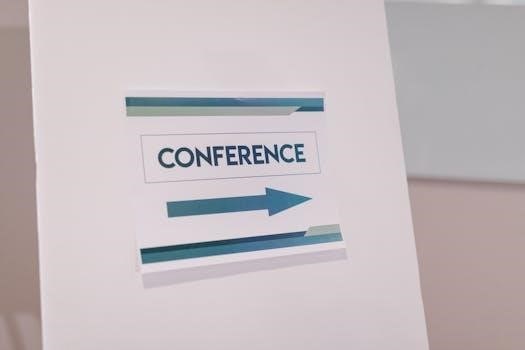Robert Gagné, a pioneer in educational instruction, introduced his Nine Events of Instruction in 1965․ This model provides a framework for designing effective learning experiences․ Gagné’s work focuses on facilitating internal learning processes by addressing mental conditions for learning․
Overview of Robert Gagné’s contributions to instructional design
Robert Gagné significantly impacted instructional design through his systematic approach to learning․ He identified nine specific events crucial for effective instruction, outlined in his “Conditions of Learning․” Gagné’s model emphasizes the mental processes involved in learning, moving away from passive, teacher-centered approaches․ His work provides a structured method for designing lessons that address different stages of cognitive processing․ By aligning instruction with these events, educators can enhance attention, retention, and the practical application of knowledge․ Gagné’s contributions remain influential for creating engaging and meaningful learning experiences, whether in traditional classrooms or modern online environments․ His principles are used to ensure lessons are effective and engaging from beginning to end, making complex learning concepts more accessible․

The Nine Events Explained
Gagné’s Nine Events of Instruction outline a structured approach to learning․ These events are designed to enhance attention, promote knowledge retention, and facilitate the practical application of skills․ Each event addresses specific mental conditions for learning․
Gaining Attention
The first crucial step in Gagné’s framework is gaining the learner’s attention․ This initial phase is paramount because focused learners are more receptive to the material․ It’s widely accepted that attracting participants to a training session is relatively easy; however, the real challenge lies in capturing their attention within the first few seconds or minutes․ This critical period sets the tone for the entire learning experience․ Techniques such as using a catchy, relevant, and provocative statement or question can serve as effective “hooks” to draw learners in․ By using these methods, educators can ensure that the learning process begins with a concentrated and engaged audience, setting the stage for more effective knowledge transfer and retention throughout the instructional program․
Informing Learners of Objectives
Clearly communicating learning objectives to students is the second vital event in Gagné’s model․ This step ensures that learners understand what they are expected to achieve by the end of the instruction․ This upfront transparency helps to set expectations and provides a sense of purpose for the learning activities․ When learners are aware of the intended outcomes, they are better positioned to focus their efforts and engage in the learning process more effectively․ By stating clear objectives, educators can also enhance the learner’s motivation by establishing a clear path and allowing the learner to understand how the content connects to broader learning goals․ This step is essential for ensuring that the learning experience is both efficient and purposeful, leading to better knowledge acquisition and retention․
Stimulating Recall of Prior Learning
The third event in Gagné’s framework, stimulating recall of prior learning, emphasizes the importance of activating existing knowledge structures before introducing new material․ This step is crucial because it helps learners make connections between what they already know and what they are about to learn․ By prompting students to remember relevant concepts, facts, or skills, educators can create a cognitive bridge that facilitates the encoding and storage of new information․ This reactivation process not only improves comprehension but also enhances retention by linking new knowledge to existing cognitive networks․ Effective strategies for this step include brainstorming sessions, brief review activities, or posing questions that relate to previous learning experiences․ This connection is a vital part of effective learning․
Presenting the Stimulus
Following the recall of prior learning, the next crucial step is presenting the stimulus․ This involves delivering the new content or information to the learners in a clear and engaging manner․ The stimulus can take various forms, such as text, images, videos, or audio, and should be designed to maximize cognitive processing and learner engagement․ It’s vital that the information is presented in an organized and structured way, making it easy for learners to understand and retain․ This stage is about ensuring that the core content is accessible and presented in a format that facilitates effective learning․ Effective presentation methods are key for the next stages of the process․ This event is a key part of the learning process․
Providing Learning Guidance

After presenting the stimulus, it is essential to provide learning guidance to help learners process the new information effectively․ This involves offering strategies and techniques that support understanding and retention․ Learning guidance can take the form of examples, analogies, case studies, or visual aids․ It should also include opportunities for learners to actively engage with the material through activities or discussions․ The goal is to bridge the gap between the presented information and the learner’s existing knowledge base․ By providing structured support, learners are more likely to grasp complex concepts and develop a deeper understanding․ Guidance helps to ensure the learning is effective and easily applied․ This stage is about facilitating the effective processing of the presented stimulus․

Eliciting Performance
Eliciting performance is a crucial step where learners demonstrate their understanding and skills based on the instruction they have received․ This involves providing opportunities for learners to actively apply what they’ve learned․ Performance can be elicited through various methods such as quizzes, exercises, problem-solving tasks, or practical demonstrations․ The key here is to ensure that the activities are directly related to the learning objectives․ It’s not just about testing recall but also about evaluating the learner’s ability to apply knowledge in meaningful ways․ Eliciting performance allows both learners and instructors to gauge the effectiveness of the instruction․ This stage acts as a bridge between learning and application, allowing for necessary adjustments to instruction or learning strategies․
Providing Feedback
Providing feedback is an essential component of the learning process, especially after eliciting performance․ This stage involves offering constructive and specific information to learners about their performance․ The feedback should highlight areas of strength and identify areas needing improvement․ It’s crucial that feedback is timely, descriptive, and actionable, so learners can effectively utilize it to adjust their learning or skills․ Effective feedback goes beyond simply marking answers as right or wrong․ It provides explanations and guidance to help learners understand their mistakes and how they can enhance their understanding․ The aim is to help learners refine their skills and move towards mastery․ Feedback is not only for the learner’s benefit; it also provides valuable information to the instructor about the effectiveness of the instruction․
Assessing Performance
Assessing performance is a critical step in Gagné’s Nine Events of Instruction, designed to evaluate the effectiveness of the learning process․ This event goes beyond simple testing; it is about measuring the extent to which learners have achieved the stated objectives․ The assessment should be aligned with the learning goals and should provide an accurate measure of the learner’s acquired knowledge or skills․ It can take various forms, including quizzes, projects, discussions, or practical demonstrations, depending on the nature of the material and the learning outcomes․ The goal is not just to assign grades but to determine if learners can apply their new skills and knowledge․ The feedback from the assessment should inform subsequent instruction and provide insights into areas where learners may require additional help or practice․ This stage ensures that learning is not just passive but is actively demonstrated and evaluated․
Enhancing Retention and Transfer
Enhancing retention and transfer is the final, yet crucial, event in Gagné’s Nine Events of Instruction, focusing on ensuring that learning is not only acquired but also remembered and applied in new contexts․ This stage is designed to help learners solidify their knowledge and skills, and to be able to use them effectively beyond the immediate learning environment․ Strategies for enhancing retention include spaced repetition, review sessions, and opportunities for learners to actively recall the information․ Transfer is facilitated by providing opportunities for learners to apply what they’ve learned in novel situations, encouraging them to use their new skills and knowledge in different scenarios․ This event may involve activities such as problem-solving, case studies, or simulations, which allow learners to adapt their learning to new situations․ By focusing on both retention and transfer, this final step ensures that learning is both durable and practical․

Applications and Impact
Gagné’s Nine Events of Instruction have a broad impact on instructional design․ They are used in online learning, and also compared to models like ADDIE․ The model helps create effective and engaging learning experiences․
Use in Online Learning Environments
Gagné’s Nine Events of Instruction offer a structured approach to designing effective online learning experiences․ The model ensures learners are engaged from the outset by first gaining their attention, which is crucial in a digital environment where distractions are abundant․ Clearly stating learning objectives helps students understand what they are expected to achieve, increasing motivation and focus․ By stimulating recall of prior learning, the online course builds on existing knowledge, making new information more accessible․ Presenting the stimulus in a clear and concise way is vital in online formats․ Providing learning guidance through various online tools like interactive videos and quizzes helps learners understand the material better․ Eliciting performance through online assignments ensures active learning․ Feedback is provided promptly and constructively to guide students․ Assessing performance using online testing methods helps determine whether the objectives have been met․ Finally, enhancing retention and transfer by offering practical applications and additional resources solidifies the learning process․ This approach transforms online learning from passive to a sequenced, engaging experience․
Comparison with Other Instructional Design Models
Gagné’s Nine Events of Instruction, while comprehensive, differs from other instructional design models like ADDIE and Merrill’s First Principles․ ADDIE (Analysis, Design, Development, Implementation, Evaluation) is a more general framework, whereas Gagné’s model focuses specifically on the sequence of events that enhance learning․ Unlike ADDIE’s cyclical approach, Gagné offers a linear sequence of instructional events․ Merrill’s First Principles, emphasizing problem-centered learning, contrasts with Gagné’s focus on cognitive processing and the structure of instruction․ While Gagné’s model provides a detailed structure for lesson delivery, Merrill’s model prioritizes the practical application of knowledge; Action Mapping, on the other hand, is more geared towards immediate, job-related outcomes, differing from Gagné’s focus on comprehensive cognitive learning․ Unlike models like Bloom’s Taxonomy, which is used to classify educational learning objectives, Gagné’s model focuses on the instructional process․ Gagne’s framework is about how to deliver the material effectively, while others are about what should be learned․




